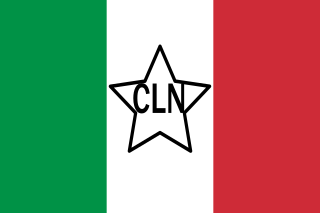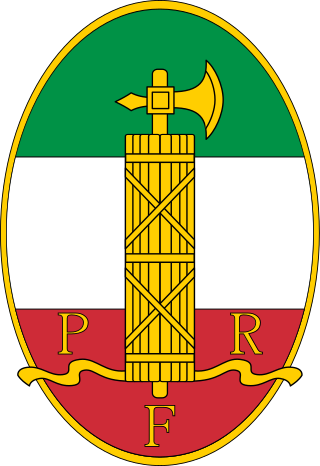Related Research Articles

Alessandra Mussolini is an Italian politician, television personality, model and former actress and singer. Mussolini has been a member of both houses of the Italian Parliament as well as the European Parliament. She is also known for being a member of the Mussolini family as a granddaughter of Benito Mussolini. Since 2022, she has been a Member of the European Parliament for Forza Italia.

The Italian Social Republic, known prior to December 1943 as the National Republican State of Italy, but more popularly known as the Republic of Salò, was a German puppet state and fascist rump state with limited diplomatic recognition that was created during the latter part of World War II. It existed from the beginning of the German occupation of Italy in September 1943 until the surrender of Axis troops in Italy in May 1945. The German occupation triggered widespread national resistance against it and the Italian Social Republic, leading to the Italian Civil War.

The Italian Resistance consisted of all the Italian resistance groups who fought the occupying forces of Nazi Germany and the fascist collaborationists of the Italian Social Republic during the Second World War in Italy from 1943 to 1945. As a diverse anti-fascist and anti-nazist movement and organisation, the Resistenza opposed Nazi Germany and its Fascist puppet state regime, the Italian Social Republic, which the Germans created following the Nazi German invasion and military occupation of Italy by the Wehrmacht and the Waffen-SS from 8 September 1943 until 25 April 1945.

The Auxiliary Corps of the Black Shirts' Action Squads, most widely known as the Black Brigades, was one of the Fascist paramilitary groups, organized and run by the Republican Fascist Party operating in the Italian Social Republic, during the final years of World War II, and after the signing of the Italian Armistice in 1943. They were officially led by Alessandro Pavolini, former Minister of Culture of the fascist era during the last years of Fascist Italy.

The Republican Fascist Party was a political party in Italy led by Benito Mussolini during the German occupation of Central and Northern Italy and was the sole legal representative party of the Italian Social Republic. The PFR was the successor to the National Fascist Party but was more influenced by pre-1922 early radical fascism and anti-monarchism, as its members considered King Victor Emmanuel III to be a traitor after his signing of the surrender to the Allies.

Opera Nazionale Balilla (ONB) was an Italian Fascist youth organization functioning between 1926 and 1937, when it was absorbed into the Gioventù Italiana del Littorio (GIL), a youth section of the National Fascist Party.

The Fasci Italiani di Combattimento was an Italian fascist organisation created by Benito Mussolini in 1919. It was the successor of the Fasci d'Azione Rivoluzionaria, being notably further right than its predecessor. The Fasci Italiani di Combattimento was reorganised into the National Fascist Party in 1921.

Ida Irene Dalser was the first wife of Italian fascist dictator Benito Mussolini.

The Italian Civil War was a civil war in the Kingdom of Italy fought during the Italian campaign of World War II between Italian fascists and Italian partisans and, to a lesser extent, the Italian Co-belligerent Army.

Ubaldo Soddu was an Italian general and politician who held the position of Deputy Chief of Staff of the Army and Undersecretary of State for War during the initial phases of World War II. On 13 June 1940, immediately after the outbreak of hostilities with France and the United Kingdom, he assumed the position of deputy chief of the General Staff. Promoted to army general, he replaced general Sebastiano Visconti Prasca as commander of the Albanian Higher Troop Command during the Greco-Italian War on 8 November 1940. Because of the defeat Italian troops suffered between 22 and 23 November 1940, he was replaced after four weeks in command by the Italian Royal Army's chief of staff, General Ugo Cavallero.
Women in Italy refers to women who are from Italy. The legal and social status of Italian women has undergone rapid transformations and changes during the past decades. This includes family laws, the enactment of anti-discrimination measures, and reforms to the penal code.

The Academia della Farnesina, also known as the Accademia fascista maschile di educazione fisica or Accademia fascista della Farnesina, was a centre for sport and political education in Fascist Italy.

Giuseppe Cobolli Gigli was an Italian engineer and politician. From 1935 to 1939, he was member of Benito Mussolini's Italian fascist government as minister of public works.
This is a list of words, terms, concepts, and slogans in the Italian language and Latin language which were specifically used in Fascist Italian monarchy and Italian Social Republic.
Sansepolcrismo is a term used to refer to the movement led by Benito Mussolini that preceded Fascism. The Sansepolcrismo takes its name from the rally organized by Mussolini at Piazza San Sepolcro in Milan on March 23, 1919, where he proclaimed the principles of Fasci Italiani di Combattimento, and then published them in Il Popolo d'Italia, on June 6, 1919, the newspaper he co-founded in November 1914 after leaving Avanti!

Ines Donati was a political activist and a supporter of the first wave of Italy's Fascist movement.

The Sandro Italico Mussolini School of Fascist Mysticism was established in Milan, Italy in 1930 by Niccolò Giani. Its primary goal was to train the future leaders of Italy's National Fascist Party. The school curriculum promoted Fascist mysticism based on the philosophy of Fideism, the belief that faith and reason were incompatible; Fascist mythology was to be accepted as a "metareality". In 1932, Mussolini described Fascism as "a religious concept of life", saying that Fascists formed a "spiritual community".
The Female Voluntary Corps for Auxiliary Services of the Republican Armed Forces (Italian: Corpo Femminile Volontario per i Servizi Ausiliari delle Forze Armate Repubblicane, better known as the Female Auxiliary Service was a women's corps of the armed forces of the Italian Social Republic, whose components, all voluntary, were commonly referred to as auxiliaries.

Sabato Martelli Castaldi was an Italian Air Force general and a member of the Italian Resistance during World War II. He was executed during the Ardeatine massacre.
References
- 1 2 Miriam Mafai, Natalia Aspesi, Le Donne italiane: il chi è del '900, Rizzoli, Milano 1993, p. 240.
- 1 2 "Gatteschi Fondelli Piera"
- 1 2 3 “Storia di Piera e delle altre squadriste”
- ↑ “Una pagina al giorno: Vendette demoniache, di Piera Gatteschi Fondelli”
- ↑ "Storia. Donne in divisa: le ausiliarie Rsi dalla Fanolla al generale Piera Gatteschi Fondelli"